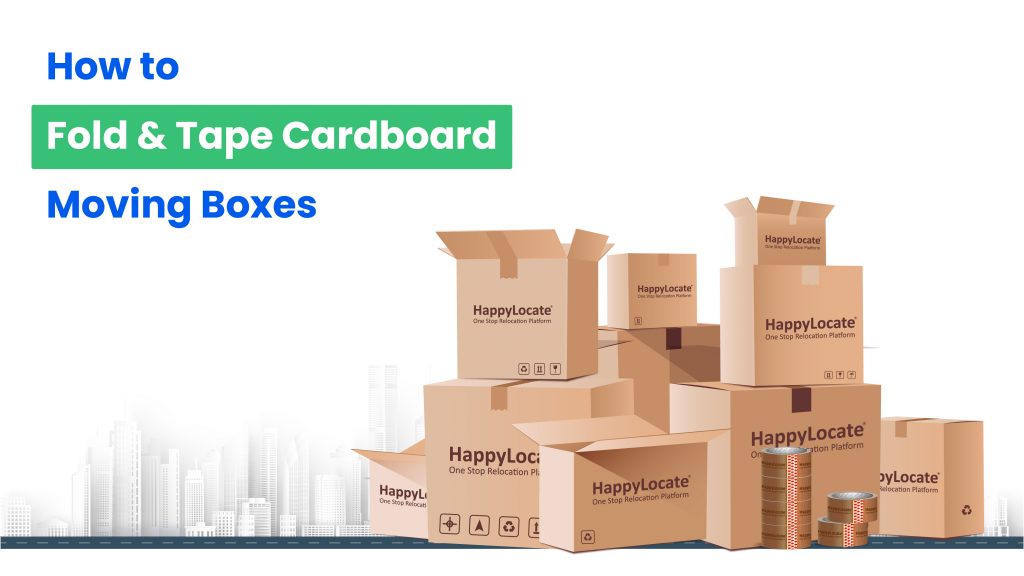The most tedious part of moving is packing; in most situations, you’ll be utilizing cardboard boxes to store your possessions in transit. Therefore, learning how to fold moving boxes is a crucial and valuable skill.
It will take a few minutes to fold and tape a moving box. You must use high-quality packing materials and secure the boxes so that they don’t collapse, open, and ruin your valuables in transit.


How to fold moving boxes?
- The boxes will likely arrive flat when you order packing materials online or visit a retailer. Put the flat box on its end, flap side up, and fold its top four flaps down until they contact the box’s exterior.
- The next step is repositioning the flat cardboard box to become a 3D rectangle shape.
- When you have a rectangular cardboard box, turn it over, so the four folding flaps are now facing down. A total of four upward-pointing flaps should be attached to the upper side of the box.
- First, fold in the box’s little flaps to shut it up. Next, tuck in the bigger folds on top.
- Tape across the middle to keep the flaps from shifting while in transit. Once the lid is on and the flaps are fastened, you can start packing. Once you have finished packing and labelling your boxes, you can follow these instructions to seal them.
Techniques for taping moving boxes
While taping a relocation package may seem like a simple task, it can lead to wasted time, money, and stressed-out nerves if done improperly. Moving with poorly sealed boxes can result in broken or lost belongings, property damage and even personal injury. The outcome of the move depends on the quality of the tape you use to seal your boxes.Qualities to look for in box-packing tape
Powerful, adhesive, temperature-resistant, and user-friendly, tape checks all the boxes for a successful move.1. Strength
When packing a box for a move, the tape should serve as a seal, reinforcement, and a means to keep the box closed. Thus, you need tape that is both strong and resistant to tearing, as this will increase the box’s resilience during transport. The strength of a tape is determined by its adhesive quality, thickness, and width. Adhesion – First and foremost, if you want to seal a box, you’ll need sticky tape. The adhesiveness of a tape is proportional to its quality and the type of adhesives it contains. The best packaging tapes have acrylic glue that is both durable and clean-cut. Thickness– The thickness determines the strength of the tape. The typical thickness of packing tape is between 1.9 mm (for thinner tapes) to 3.1 mm (for heavier-duty tapes). More substantial packages call for more substantial tape. Width– It needs to be broader than the seam to keep the tape in place when the box is sealed. The wider the tape, the more it can support, making it ideal for sealing big boxes during a move. Tape between two and three inches wide is ideal for sealing moving boxes.2. Intriguing fact
The tensile strength of a tape is a quantitative measure of its load-bearing capacity. Be sure to use packing tape with good strength when closing moving boxes.3. Resistant to temperature
Since your belongings won’t spend much time in the moving van if you’re only going a short distance, the tape you use on your boxes won’t be affected by the weather. However, your possessions will be in transit for several days if you’re relocating across the country. So, if you’re relocating in the summer, make sure the tape you use to seal your boxes won’t come undone from the heat, and if you’re relocating in the winter, make sure the tape can resist the cold.4. Effortless operation
Time is of the essence when packing a home for a move. Therefore, you don’t want to waste any of it struggling with the tape. Therefore, it is preferable to acquire high-quality tape that will be applied with a hand-held tape dispenser, as this will save you time and effort in the long run as you won’t have to waste time preventing the tape from separating or searching for the end that has clung back to the roll. You can save time and energy by using a dispenser to pack your boxes. While packing tape has many benefits that are hard to dispute, there are times when you might wish to use another sort of tape for sealing your moving boxes. Gummed tape- Water activates the glue in gummed tape. It’s more challenging to use than other tapes and can’t be removed without leaving a scar on the carton, but it provides a robust and permanent adhesive. As a result, you should only use it for big moving boxes that require a great distance to travel, and you shouldn’t use it for boxes you plan to keep. Filament tape- Filament tape is an excellent choice for sealing big boxes for long-distance transport due to its resistance to temperature changes and its tensile strength. Tape with labels- Sealing and labeling functions are combined in labeled tape, which comes in different colors to help you quickly identify which room a package should be placed. It can be seen from all corners of the box, so you and the movers will know exactly where to put each item when you get to your new house.How to tape cardboard moving boxes?
This is how to seal up boxes properly so they don’t damage during the move.Step 1
Make sure a cardboard box has a solid base that won’t give way or crack open underneath a load of your contents before you stuff it with anything. To put it another way, you must tape up the box’s bottom; otherwise, if you merely wrap the bottom flap over one another, the box could fall when raised. Let’s see how we do this.- First, fold the box folding the two smaller sides toward the middle, followed by the two bigger flaps, and last, flip the box over and fold down the sides into the interior of the box.
- Secure the long horizontal split in the center (where the flap edges meet) with tape, being careful to get a little on both sides. You must make sure the tape hangs over the edges.
- Tape each flap that hangs over the edge of the box shut. Keep the tape pressed firmly on the cardboard surface to ensure a strong bond.
- It’s possible to increase the tape’s security by adding two more strips, each on the other end of the long section in the center, overlapping them halfway.
- However, this is necessary to consider only if the tape is narrow enough.
- We recommend adding further reinforcements to the box for maximum security. Depending on what you plan to store in the box, you can choose one of the various methods for securing the bottom
1. “Snowflake” technique
When stowing bulky, heavy objects in a suitcase draw an “X” with tape (over the center strip) across the edge to edge in both directions; draw two parallel tape strips near the box’s ends, moving opposite to the large strip of tape in the middle.2. Using the H-method
The H-method is recommendable for packing fragile and sensitive products since it not only aids in evenly distributing the box’s contents but also secures the side seams so that nothing can enter the carton and destroy your belongings. With this technique, the shorter vertical joints on either side of the box are taped: Overlap the tape on one seam side at a width roughly half its size. Allow an overhang at each end, and fold the tapes around one corner to resemble a triangle. Fold the excess to the sides of the box; repeat on the opposite corner, and then press the tape flap tightly to the cardboard. Similarly, deal with the overhangs.3. Diagonal strip technique
Putting less effort into reinforcing the box if you’re packing light, non-breakable things is okay. You can seal the bottom of the box with minimal tape by employing the “diagonal strip method,” which entails running a stretch of tape throughout the bottom and then diagonally to the first strand of tape in the middle. It’s strong enough to hold the box and your belongings while transporting them.Step 2
- After stuffing the box, seal the top. Press down in the center to compress the flaps and bring them together.
- Cover the entire horizontal opening in the centre with tape, letting it hang over the edges of the box.
- A strip of tape can be run perpendicular to the central strip, creating a triangle, or two parallel tapes can be added on top of the centre line (going oppositely).
- When the box is full, secure the lid. Make sure the flaps are touching by pressing down gently in the middle.
- Wrap some tape around the outside of the box and tape down the middle horizontal seam.
- After that, you can add two more parallel tapes on top of the central line or a strip of tape at a diagonal to the centre line.
- The H-method, mentioned above, is an extra layer of protection if you have put fragile or heavy things in the box.
Conclusion
If you take the time to build sturdy moving boxes, your possessions will arrive at their new home unharmed. How well you seal your moving boxes is a crucial factor in ensuring a trouble-free transition. HappyLocate is here to assist you in every way we can to ensure a smooth relocation. A relocation checklist, personal duties list, and helpful suggestions are all provided by us. Warm wishes for a successful relocation.Packers and Movers in India
Top Packers and Movers in Ahmedabad
Packers and Movers in Bangalore
Best Packers and Movers in Chennai
Packers and Movers in Delhi
Top Packers and Movers in Gurgaon
Packers and Movers in Hyderabad
Best Packers and Movers in Mumbai
Packers and Movers in Pune


